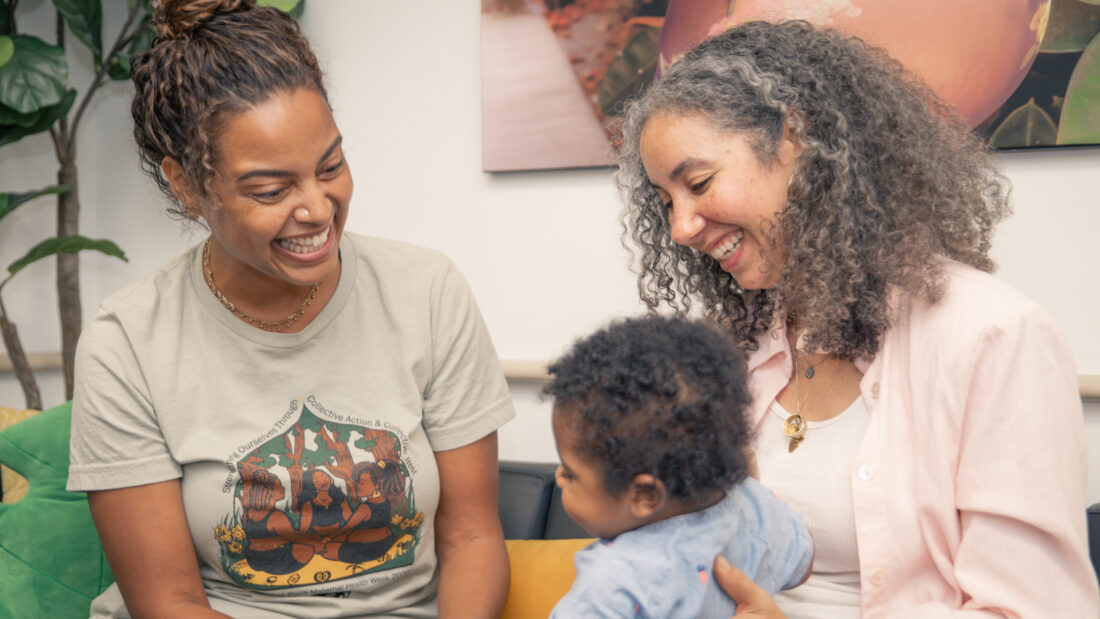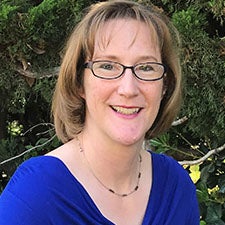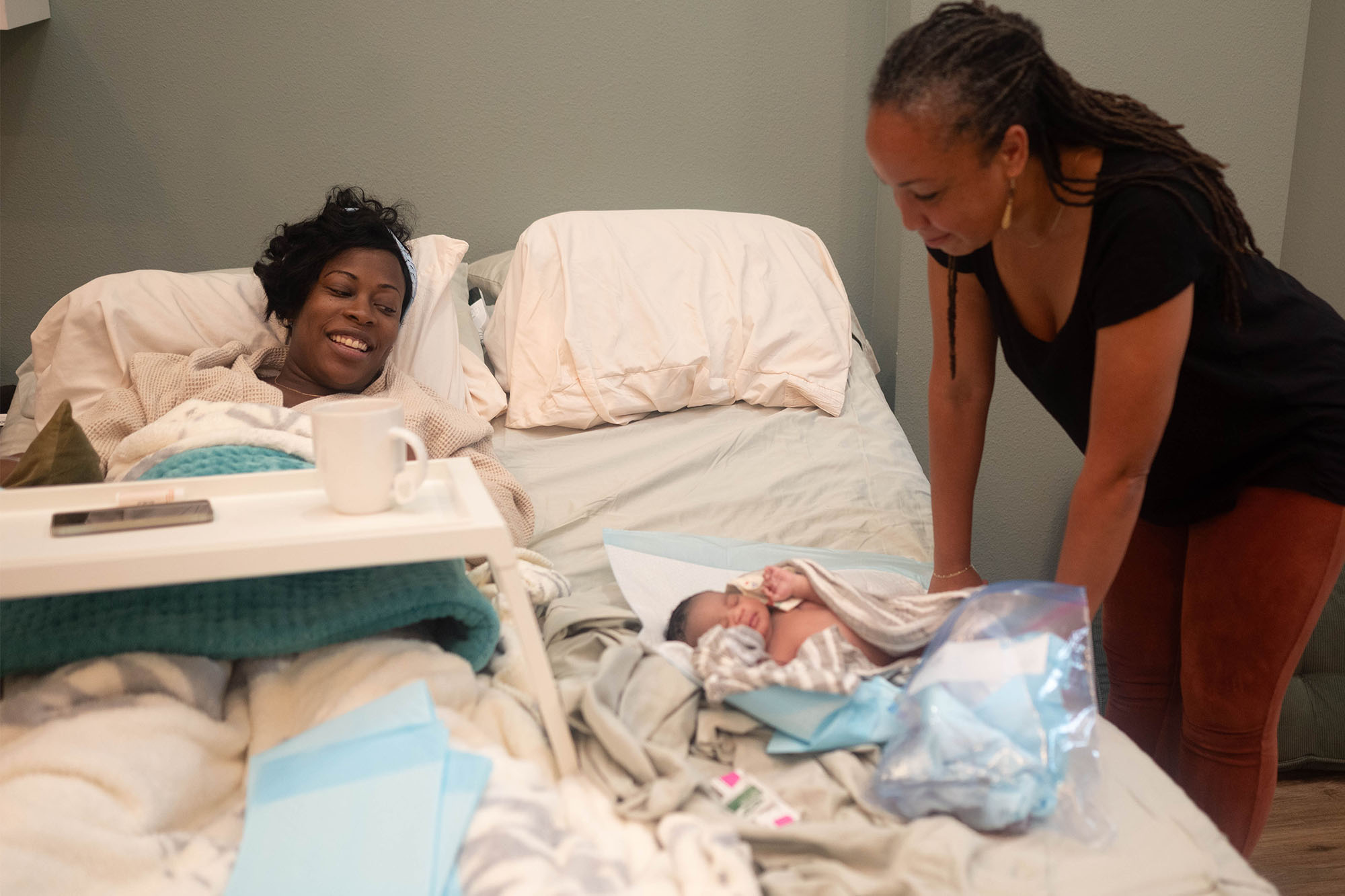|
Getting your Trinity Audio player ready…
|

∘ Family Physicians Can Increase Access to Maternity Care … Story below
When Delphine Sims showed up for her first prenatal care appointment with the Alameda Health System, she was expecting an OB-GYN to walk into the exam room. But Sims was excited when she learned she could receive her maternity care through a midwifery program that gave her access to Black midwives, breastfeeding specialists, doulas, nutritionists, therapists, and more. The program, Beloved Black Birth Centering, provides holistic and racially concordant care led by midwives with the goal of improving outcomes for Black mothers.
“I was impressed with the midwives,” said Sims. “They had such a thorough understanding of my health needs during pregnancy, and they helped me feel secure as I was going through something so unknown.”
Sims joined a Beloved Birth group with eight pregnant women who were due in May 2024. Twice a month, midwives and public health facilitators led discussions about preparing for birth, newborn care, and more. During group visits, patients individually saw a midwife who checked on the health of the mother and baby.
“The meetings felt like a family reunion,” said Sims, who did not have family in the area or friends who had children. Though she was afraid of the labor and delivery process, she felt reassured and more confident after the midwife invited each member of the group to share experiences of overcoming difficulties in life. “I’ve never felt so supported by a health care system,” said Sims. Midwives helped her deliver a healthy baby boy in April 2025.
Like Sims, many people are accustomed to seeing OB-GYNs for maternity care even though other types of providers can deliver babies. Research shows that access to maternity care improves outcomes for both mothers and babies, yet the state’s demand for OB-GYN doctors is projected to exceed supply by 1,160 full-time equivalents within five years. The labor shortage and the high costs of keeping hospital labor and delivery units open has led to more than 50 California hospitals closing or indefinitely suspending their units since 2012. It’s a trend that is severely limiting access in rural communities, for families with low incomes, and for people of color.
Forced to Travel
Many expectant mothers are forced to travel farther to access the care they need, which increases the risk of adverse outcomes. In the United Kingdom, France, and Norway, midwives perform a high percentage of births, but that is not the norm in the United States.
“While we need more physicians who can deliver babies, the majority of people can safely receive all of their maternity care, including birth, from a midwife,” said Holly Smith, a certified nurse-midwife and legislative coordinator for the California Nurse Midwife Association.
Midwives provide comprehensive care for low-risk patients before, during, and after the baby is born, and they involve patients in the decisionmaking around birth. When cases get medically complicated, they transfer care to a local physician. Although midwives are poised to provide much-needed reinforcement to the dwindling obstetric workforce, they are encountering obstacles to obtaining hospital privileges, low insurance reimbursement rates, and a dwindling number of training programs.
Maternal health experts worry that patients will suffer unless the state addresses the hurdles that are preventing midwives from providing care to mothers and pregnant people. “There is a shortage of OB providers nationally and in California, and in the next five to 10 years, the shortage is projected to get much worse,” said Smith. “To reduce the risk of adverse outcomes, we need to create more access points for patients to get prenatal care and give birth safely.”
Midwives Reach Underserved Populations
Although midwives are trained specifically to provide maternity care, only 14% of the 430,000 births in California were delivered by midwives in 2021. The supply of midwives varies across regions, with a high of 84 practicing midwives per 10,000 births in the Northern and Sierra regions and a low of 11 per 10,000 births in the Inland Empire and the San Joaquin Valley.
California credentials two types of midwives: Certified nurse-midwives (CNMs), who complete a graduate-level nursing program such as a master’s or a doctor of nursing practice (DNP) ; and licensed midwives (LMs), who are trained in three-year programs and mainly practice in birth centers or homes. The state has 1,200 certified nurse-midwives and 500 licensed midwives.
There are only two training programs for licensed midwives and two for certified nurse-midwives. “Without more funding from the state and federal government to create midwifery training programs and support clinical placements, we won’t be able to expand the supply,” Smith said.
Once they graduate from these programs, midwives consistently confront hospital restrictions that keep them from practicing to the full scope of their training. In a 2023 survey, nearly one in four California midwives reported that they never, seldom, or only occasionally were able use the full extent of their expertise in their own practices.
Alameda Health System is bucking this trend by welcoming midwives to their maternity care operations. Today, more than 70% of the babies delivered within the Alameda system are delivered by midwives. Jyesha Wren, a certified nurse-midwife who grew up in a California family with low income, was drawn to join them.
In 2019, she founded Beloved Birth Black Centering at Alameda Health System, in collaboration with the Alameda County Public Health Department, and the Beloved Birth Collective. Black mothers and pregnant people have disproportionately high rates of preventable complications during pregnancy and birth. Beloved Birth includes services that have been proven to help Black families thrive, such as more time with health care providers and supplies for pregnancy, birth, and postpartum. Black midwives in the program explain to patients that they are not predestined to have complicated pregnancies. “They talk about how racism is causing this and how patients can increase their chances of a having a healthy outcome,” Wren said.
Low Reimbursement Rates
Birth centers are another pathway for patients to access midwives. These freestanding health care facilities provide prenatal, birth, and postpartum care for low-risk pregnancies. In 2020, California had 20 licensed birthing centers, but in the last five years, 17 have closed as midwives grappled with low insurance reimbursement rates for maternity care and complex regulatory requirements.
Elizabeth Smith, a certified nurse-midwife and former owner of a birth center in Santa Rosa, was forced to shut it down in 2023 because she could no longer afford the increasing labor costs of midwives and staff, malpractice insurance premiums, medical supplies, and more. More than 80% of her patients were Medi-Cal enrollees, and Medi-Cal reimbursement rates for maternity care had not increased for decades.
She now works independently in rural areas through her private practice. She is saddened by the decreasing access to birth centers that are so helpful to underserved patients. At her birth center, more than 90% of mothers stuck with long-term breastfeeding, rates of postpartum depression and anxiety were low, and cesarean sections were under 10% — well below the national average of more than 30%.
As the state works to address the shortage of obstetric providers, she hopes midwives are included in plans to improve access to maternity care. “There are tremendous financial barriers midwives face with low reimbursement rates and the high cost of doing business,” she said. “All of that can be fixed by better reimbursement rates.”
Although OB-GYNs deliver most of the babies in California, midwives throughout the state are working to shift the cultural norm that often sidelines other types of clinicians who can serve pregnant patients. By increasing awareness about their vital role in maternity care, midwives hope to improve the health of mothers, babies, and families — especially in rural and low-income communities.
“Underserved populations have a higher incidence of mortality and morbidity in childbirth,” Smith said. “For people on the margins, the ability to access maternity care that speaks directly to their needs can change outcomes.”
Family Physicians Can Increase Access to Maternity Care
Family physicians provide acute, chronic, and preventive medical care for patients of all ages — and that includes prenatal care of moms and pregnant people as well as labor and delivery care. While less than 10% of mid- or late-career family physicians in the US deliver babies, they represent an important resource for increasing rural patients’ access to maternity care.
Like midwives, family physicians sometimes encounter significant barriers to doing the work, including difficulty obtaining hospital privileges to deliver babies.
But family medicine doctors are making progress in gaining a foothold in health systems. For Robin Linscheid, MD, an associate professor of family medicine at UCSF Fresno, her journey began by talking to OB-GYNs at Clovis Community Hospital near Fresno about her obstetrics training. She could provide prenatal and postpartum care and perform low-risk deliveries.
After gaining privileges to deliver babies at Clovis, she became an integral part of the obstetrics team. “When I work with OB-GYNs, it’s a mutually beneficial relationship,” she said. They may seek her guidance about how to treat substance use or sexually transmitted infections like syphilis and HIV, and the OB-GYNs help her with management of early preterm labor or complex pregnancies with uterine anomalies.
When the hospital’s parent company wanted to scale back privileges for family medicine doctors, “the OB-GYNs went to bat for me,” she said. “They explained to the administration that they didn’t have the capacity to take on all of my work.”
Redefining Residency: Birth Training in Community Settings
For patients at Shasta Community Health Center in Redding, a federally qualified health center, family medicine residents deliver more than half of the babies at nearby Mercy Medical Center. After completing residency, though, it can be difficult for new doctors to find hospitals elsewhere in California that will grant privileges to deliver babies, said Amanda Mooneyham, MD, program director of the Shasta Community Health Center residency program.
“These residents are skillful in their ability to manage labor and deliver, and it’s unfortunate that many can’t continue using these skills,” Mooneyham said. She hopes a bill that passed in September 2025 will open pathways for alternative delivery staffing model in rural communities. The bill requires the California Department of Public Health to establish a five-year pilot program allowing rural hospitals that are at least 60 minutes from a hospital providing full maternity services to create standby perinatal units. Qualified family physicians and obstetricians could provide the needed care. Rather than remaining open 24/7 with a full labor and delivery staff, which is expensive, providers in the stand-by unit would be on-call for deliveries.
This model could create a pathway for family medicine doctors like Kelsi Camacho, MD, MPH, a family medicine/obstetrics resident at UC Davis Health who is interested in practicing in a rural area. Though she would prefer to return to her hometown of Weaverville, 30 miles west of Redding, the nearest hospital maternity service is an hour away, and that is too far to manage births on a regular basis.
“My dream is to return to Weaverville, but the only local hospital closed the labor and delivery unit,” she said. “I love obstetrics because it is exciting and there is potential for such happy outcomes, and my goal is to practice in a rural community.”
Family physicians are working to open more pathways to provide maternity care, but even the best outcome can’t satisfy the high demand for services in rural areas. California needs a united system of family physicians, midwives, and other maternity care providers to deliver secure and prompt medical services to all pregnant individuals in the state.
—Heather Stringer
Editor’s note: CHCF uses the term “mothers” in this article but recognizes that not all people who become pregnant and give birth identify as women or mothers.
Authors & Contributors

Heather Stringer
Freelance writer and editor
Heather Stringer is a freelance health and science journalist based in San Jose.

Christopher Williams
Freelance photographer
Christopher Williams is a San Francisco-based photographer who has completed photoshoots around the world, including in the US, Europe, Haiti, Hong Kong, and Morocco.




